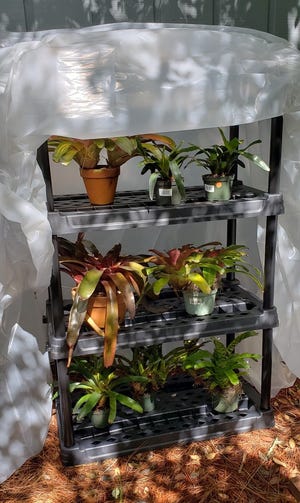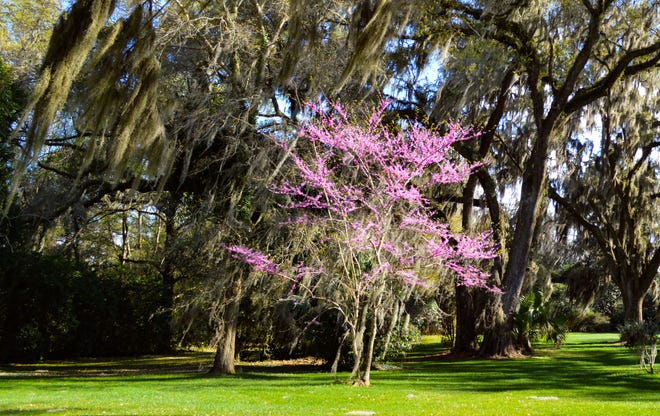David W. Marshall

Our two past winters have been extremely moderate. But we have already had a killing freeze this wintertime. So tender vegetation like variegated shell gingers and Hawaiian ti crops experienced their leaves burned again seriously by the post-Christmas freezes.
There probable has been some stem destruction to these chilly-sensitive vegetation, far too. But it can take time right after a freeze ahead of you can notify how in depth the stem damage was. For that cause, and mainly because we will most most likely have more freezes, it is sensible to wait right until at the very least a minimal afterwards in the winter season to commence pruning these crops back again. There is no damage in waiting around until late February if you would like.
Young citrus vegetation are also prone to freezes, such as we experienced just lately, when the temperatures dip down into the mid to reduced 20s and keep beneath freezing for 12 hours or so. Satsumas and kumquats could not be afflicted at all, but lemons and oranges are far more delicate.

Protection from the cold
So, what if we have more and probably even a lot more serious hard freezes this winter? How do you secure delicate vegetation? If the plant is small more than enough that the entire plant can be included, that may perhaps be an solution. But be informed that just throwing a sheet or gentle blanket, or even a plant frost protect, around the plant will not give substantially security against a really hard freeze.
Covering with plastic movie may well be greater, but if you decide on this process you need to have some sort of framework, these types of as stakes or a tomato ring, that will maintain the plastic up over the plant and off the leaves. The plastic has to absolutely seal in the plant, extending all the way down to the ground.
The notion is to make a mini-greenhouse and seal in the heat that radiates from the ground at night. But if the temperature drops very low plenty of and for very long ample, ground heat will not be enough, and you will need to provide some supplemental warmth these kinds of as from an incandescent light bulb.

Covering much larger vegetation, these as a bigger citrus tree, is not extremely sensible, while. You can, on the other hand, protect the decreased trunk to guard from the grafted part of the tree staying completely killed in a extreme freeze. There are numerous strategies to do this, from piling soil up all over the trunk higher than the graft, to wrapping with many levels of burlap, or even creating a cage of pine straw or hay around the trunk.
The target is to hold from getting rid of an full cold-sensitive grafted citrus tree like a lemon or orange in an exceptionally tough freeze. No a person understands what lies ahead this winter, and it will take time to place these chilly defense actions in spot, so continue to be aware of long-variety weather forecasts if you have chilly-sensitive plants so you will not uncover oneself out in the chilly at the last minute frantically making an attempt to safeguard vegetation.
Wait around to prune
Even if the trunks of a lot of of the tropical ornamentals, these as I pointed out at the starting of this column, are broken by chilly, the crops will ordinarily re-sprout from the roots when the soil warms in spring. But, as I talked about earlier, it is ideal to hold out to prune until later on in the winter, when you can thoroughly establish the extent of chilly destruction.
If the lifeless branches definitely bother you and you sense that you must cleanse them up right before that, although, you can get an strategy of where to cut by scraping the bark with your fingernail. The tissue beneath the bark on undamaged branches will usually be greenish in color as opposed to brownish on the ruined branches.
Typically, while, the decreased element of a huge plant has some undamaged reduced or inside branches and leaving the broken higher branches through foreseeable future freezes may supply a little defense of the reduce element of the plant. So, that is an additional motive I recommend waiting around until afterwards in the wintertime to do significant pruning of these damaged crops.

Planting shrubs and trees
Even with all this speak about winter season cold safety for tropical vegetation, notice that this is continue to the very best time of yr for planting woody shrubs or trees that we generally expand here and that are cold hardy.
Planting now is much more favorable than planting azaleas, loropetalums, hollies, and usual woody ornamentals in the hotter months whilst the plants are actively rising. You will have to have to water the new plants, even during the winter, but you will uncover that the root balls do not dry out as speedily now and the vegetation will be improved proven to face the warmth of the escalating year.
So, get benefit of the cooler temperature for your substantial landscape assignments.
Cherry, redbud and red maple
Amongst opportunities to plant in January and February are trees that deliver coloration in the course of this interval. Japanese magnolia, Taiwan cherry, Okame cherry, redbud, and red maple are amongst the options.
January to February is also the time to do most of your pruning. The exception for this would be with spring-blooming plants these as azaleas, loropetalums, and spiraea. Delay pruning them until finally after they flower in the spring.
But evergreen shrubs, deciduous fruit trees and vines, crepe myrtles, and roses are between plants to prune right before spring advancement starts. When pruning crepe myrtles, just take out crossing, rubbing, or poorly put branches. Generally, if you do not reduce back the tops or the ends of branches you will close up with a considerably prettier plant.
Appears to be like just yesterday when we had been possessing scorching temperature. Slide and wintertime arrived on speedy! So, if you have not kept the falling leaves and pine needles off your garden, consider time to take out them now. Use them as mulch all around trees and shrubs and in bare places. One of the best ways to do this is with a lawnmower.
This will enable you blow the leaves off the lawn and will chop them into smaller parts which are extra most likely to stay put the place you use them for mulch. Mowing the lawn now also assists to hold people winter season weeds back.
If you have to have supplemental mulch, now, when it is not warm, is also a very good time of calendar year to get pine straw or other mulch to insert to your landscape beds. You do not need to eliminate the old mulch, just include to it.

Plant pansies and snap dragons
Now that we have experienced chilly weather, does your winter season landscape abruptly lack colour? This is a fantastic time to contemplate incorporating some crops for wintertime shade. Camellia shrubs are great alternatives, even where there is some shade involved.
If you have sunny spots, plant wintertime annuals this sort of as pansies, violas, snapdragons, crimson mustard, ornamental cabbage or kale, and wallflower (Erysimum ‘Citrona Orange’ or ‘Citrona Yellow’). Evenly fertilize these annuals every month to retain them rising nicely.
Cool-season veggies these kinds of as arugula, broccoli, carrots, cabbage, cauliflower, celery, collards, lettuce, mustard, radishes, and turnips can also be planted in places that receive adequate sunshine. Plant deciduous fruit such as pears, peaches, plums, nectarines, persimmons, figs, blueberries, blackberries, grapes, pecans, chestnuts, mayhaws, and pawpaws.
Spring is just about the corner. Acquire edge of the cooler weather conditions now to plant, prune, and mulch. And delight in the harvest from citrus and interesting period veggies and herbs.
David W. Marshall is a landscape advisor with Esposito Garden Heart and an Extension Agent Emeritus with UF/IFAS Extension Leon County, an Equal Option Institution. For gardening questions, electronic mail the extension business at [email protected]
Hardly ever miss a story: Subscribe to the Tallahassee Democrat applying the link at the leading of the website page.

:max_bytes(150000):strip_icc()/house-cleaning-schedule-for-every-day-3129149-06-b23eacd9ef3a41fc833c68e095b34c72.jpg)



More Stories
How to Tackle a Leaking Tap without a Plumber
What Home Herb Garden is Right For You?
Hot Selling Products Wooden Duck Wholesale This Week